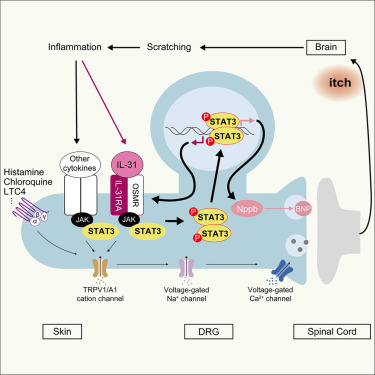Sensory neuronal STAT3 is critical for IL-31 receptor expression and inflammatory itch
Sonoko Takahashi 113, Sotaro Ochiai 11013 Jianshi Jin 211, Noriko Takahashi 1, Susumu Toshima 13, Harumichi Ishigame 112, Kenji Kabashima 45, Masato Kubo 67, Manabu Nakayama 8, Katsuyuki Shiroguchi 2, Takaharu Okada 1914
https://doi.org/10.1016/j.celrep.2023.113433
Highlights
- Sensory neuronal IL-31RA and STAT3 are essential for IL-31-induced itch
- STAT3 is important for expression and downstream signaling of IL-31 receptor
- IL-31 enhances GPCR-induced itch transmitted by multiple sensory neuronal subsets
- Sensory neuronal STAT3 contributes to IL-31-independent inflammatory itch
Summary
IL-31 receptor blockade suppresses pruritus of atopic dermatitis. However, cell-type-specific contributions of IL-31 receptor to itch, its expression mechanism, and the downstream signaling pathway to induce itch remain unknown. Here, using conditional knockout mice, we demonstrate that IL-31-induced itch requires sensory neuronal IL-31 receptor and STAT3. We find that IL-31 receptor expression is dependent on STAT3 in sensory neurons. In addition, pharmacological experiments suggest that STAT3 activation is important for the itch-inducing signaling downstream of the IL-31 receptor. A cutaneous IL-31 injection induces the nuclear accumulation of activated STAT3 first in sensory neurons that abundantly express IL-31 receptor and then in other itch-transmitting neurons. IL-31 enhances itch induced by various pruritogens including even chloroquine. Finally, pruritus associated with dermatitis is partially dependent on sensory neuronal IL-31 receptor and strongly on sensory neuronal STAT3. Thus, sensory neuronal STAT3 is essential for IL-31-induced itch and further contributes to IL-31-independent inflammatory itch.

